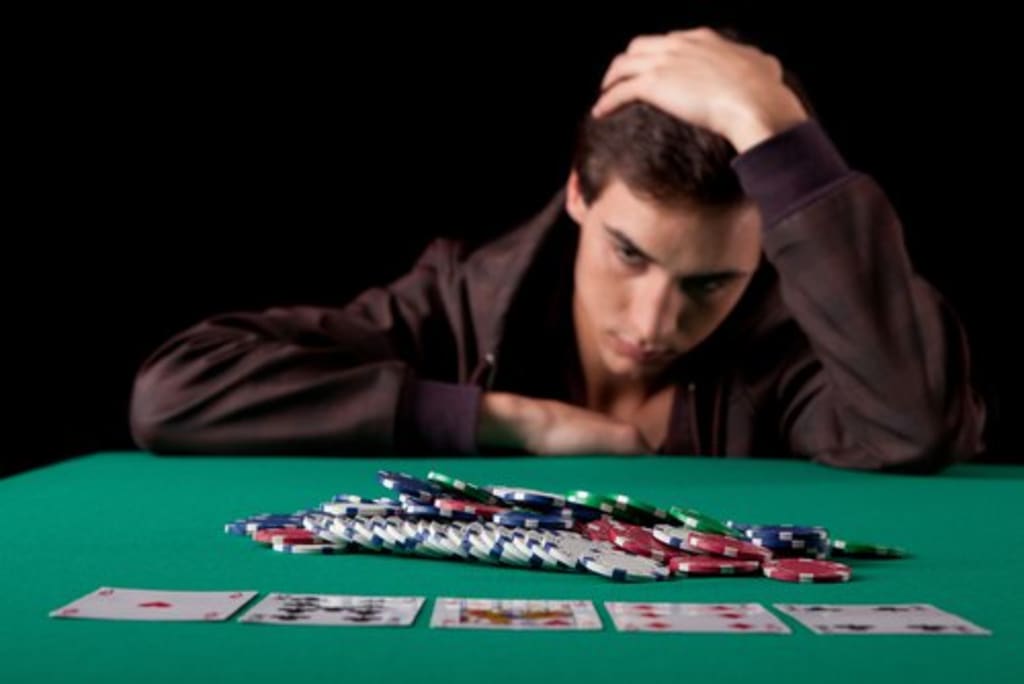
Rolling the dice once and suddenly winning a huge amount of money. Only that person knows the satisfaction because almost everyone enjoys becoming a bit richer, but he would have no idea about when this satisfaction will lead him to addiction? The thought “I am sure I will be winning this time” never allows that person to realize the amount of time and money he had spent on gambling. National surveys in 1995 and 1998 found that 61 percent to 63 percent of Americans gambled at least once a year (National Research Council Staff). Pathological gambling is different from normal recreational gambling.
Normal gambling is viewed as a source of entertainment. Pathological gambling, on the other hand, is the inability of a person to resist impulses to gamble, which may turn out to be evil for self, family, and society. “When the gambler enters the desperate phase and begins to chase his losses,” Sanger said, “he is ready to sell his daughter’s graduation dress or steal from his mother’s retirement fund to get money to gamble” (Breo, Losing Streaks).
Pathological gambling is more common in adult men than any other age groups. According to current research, out of 120 million adult Americans who gamble, approximately 11 million will end up being pathological gamblers (Paul and Townsend 1998). People will often point out their social or economic problems to be the main reasons for gambling. However, research shows that people gamble not only for excitement, but also with the hope of sudden high waves which could make them rich. The underlying influences of family and social environment, and stereotypical thinking of people that gambling can reduce the stresses caused by broken relationships, economic crisis, and so on eventually increases the ratio of people to gambling.
Interestingly enough, pathological gambling was more often considered as a kind of compulsion rather than addiction. In the 1980s, while updating statistical manual of mental disorder (DSM), the American Psychiatric Association (APA) officially classified pathological gambling as an impulse-control disorder, which was later considered as an addiction (Jabr, How the Brain Gets Addicted to Gambling).
We may often wonder "Why do people gamble even when they know it is the total waste of time and money?" “What these people are suffering is not due to lack of morals but they are instead suffering from serious mental illness,” says Carol O’Haire, executive professional of a Nevada council on problem gambling. Well, this is because of the direct physical stimuli of the chemical response. The desire to get involved in activities like gambling is based on the reward system.
In the middle of our cranium, a series of circuits known as the reward system links various scattered brain regions involved in memory, pleasure, and motivation. When people are involved in activities like gambling, neurons in the reward system squirt out two major chemical messengers called “serotonin” and“dopamine,” giving us a little wave of satisfaction (Jabr, How the Brain Gets Addicted to Gambling). Because surprising rewards are delivered when involved in gambling, which makes gambling behavior difficult to extinguish and thus becomes compulsive.
In a scientific experiment between pathological and non-pathological gamblers, subjects are placed in an fMRI, which is a modern brain imaging tool that measures the brain activities through blood flow. They are then shown the gambling cues, and the results are based on the increased or decreased brain activity in various regions of the brain. Their findings revealed that during the initial presentation of cues, pathological gamblers demonstrated relative decreases in activity within ventral striatum and ventromedial prefrontal cortex when compared with non-pathological gamblers. But, pathological gamblers showed higher activity than frequent or non-pathological gamblers in dorsolateral, prefrontal, and parietal lobe, a network particularly concerned in executive functions, while winning as compared to losing money (Jabr, How the Brains Get Addicted to Gambling ).
According to the research conducted by Welte, Barnes, Wieczorek, Tidwell, and Parker in 2002, about 82 percent of adults had gambled during the past year. Where the most popular gambling activity was the lottery, followed by raffles. They found that males and females had similar gambling rates, but males bet frequently and bet larger amounts than females. The involvement in gambling results from the reward system of the brain, however, the motivation and causes for men and women differ. According to a study conducted by Davis in 2002, females become compulsive gamblers in a short period of time as compared to male compulsive gamblers. Also, females often start gambling as recreation and then gamble to escape from their problems. Ladd and Petry found, in their study of pathological gamblers, that slot machine was the most common type of gambling for both males and females. However, males were most likely to gamble on sports and animal races.
People are involved in pathological gambling not only because they want to make money, but also because for some it is a way to escape from worldly behaviors. It’s a kind of psychological disorder which gives them pleasure when they bet. According to Jan Zacharias, gamblers can fit into five different types. The first one is the recreational gambler, who gambles just for entertainment. The second type is the social gambler who gambles for a limited time with friends. The third is the professional gambler who is skilled and choose the games they are more likely to win. The fourth one is the criminal gambler, who gambles illegally or are committed to illegal activities for money. And the last one is the pathological gambler, who spends an increasing amount of time and money to gamble. They are unable to control themselves and end up experiencing negative consequences on personal and social pursuits. Although, they feel bad about their gambling behavior they can’t help themselves from quitting that behavior. According to Dr.Robert Parkinson, about 4 percent of pathological gamblers can only quit their behavior of gambling through huge difficulties.
Typically, the pathological gambler’s life becomes dominated by the uncontrolled gambling behavior, which results in overwhelming financial burdens, an inability to maintain a career, and weak family relationships. “The enormous consequences of this disorder include high rates of suicide attempts, legal problems, and criminal behaviors (Brain Imaging and Behavior). As per the world health organization, pathological gamblers account for five percent of all suicides. The study examined 122 suicides between 2006 and 2009, of which 49 were pathological gamblers (Asian News International).
Pathological gamblers were mostly treated like criminals during the past times and were badly tortured. It was not until the 20th century that attention was paid to the treatment of pathological gamblers. “At this time the movement in psychodynamic and psychotherapy was beginning to develop, and so, not surprisingly, it turned it’s attention to gambling” (Barry, Malcolm; Cognitive Behavior Therapy).
With time, various other approaches were made based on behaviorism and cognitive principles, with varying degree of success. Moreover, adequate treatment approaches have not been subjected, due to the lack of national attention towards pathological gambling. Among all these approaches, cognitive therapy was found to be more effective than cognitive-behavioral, and behavioral treatments (Barry, Malcolm; Cognitive Behavior Therapy). Because, unlike other treatments, cognitive treatment aims to counteract underlying beliefs and behavior of the person regarding gambling that initiates undesirable and uncontrolled behavior. But, all these treatments won’t make any difference until those addicted begin to realize that the costs of their addiction exceed the benefits and when they realize gambling as a destructive agent in their life.
Most of the treatment methods are based on previous case studies, which makes it difficult to develop an accurate profile of those seeking help or trying to come out of this behavior. Psychologists have developed a new approach for the treatment of pathological gamblers, which uses fluvoxamine and other serotonin reuptake inhibitors which could help the depressed and bipolar disorder patients. However, it was found that 50 percent of the pathological gamblers don’t take the medications doctors give them, and other 50 percent don’t even show up to doctors (Pathological Gambling, 206). Conversely, pathological gambling can be studied and there are many ways to assist those who need help. The lack of realization among people that pathological gambling is a serious mental illness rather than a choice can easily breed mistrust and worsens the condition of the pathological gamblers seeking help.
In conclusion, without the actual knowledge of pathological gamblers and the actual number of patients for the treatment of this disorder, it is nearly impossible to find the gap between the need and use of treatments. Despite the improvements made in the study and treatment of pathological gamblers, this area of inquiry is still in the infancy phase. The condition of pathological gamblers is worsening, because of their unwillingness to seek treatment, lack of knowledge about how such gambling behavior can worsen the health consequences, lack of funding for treating pathological gamblers and mistrust. People should realize the facts that pathological gambling is a serious disorder, associated with various negative consequences and only self-help is not effective to quit the behavior and can be treated with the help of clinical psychologists.
The task to help the pathological gamblers won’t be easy, and the effort will be costly and mainly time-consuming. Also, there need to be more objective and extensive research and analysis of the economic, social, and personal impact of gambling. Pathological gambling is a growing problem of this modern society and public support on this shift is beyond question. Approximately, Americans wagered about $551 billion within one year in legal gambling activities. Compulsive gambling is just like other addiction such as drugs or alcohol addiction. So, the government should step up and implement laws and offer more help with rehabilitation programs for compulsive gambling. Although we may win a huge amount of money while rolling the dice once, we must also realize the costs involved for individuals, families, and communities from the pathological and problem gambling.
About the Creator
Winry
I write whatever is on my mind!






Comments
There are no comments for this story
Be the first to respond and start the conversation.